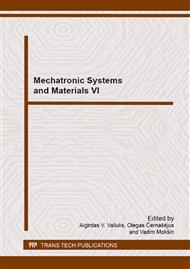[1]
Worldwide Market, International Robotic Association, information on http: /www. robotinvestments. com/RI_worldwide_market. htm.
Google Scholar
[2]
Research report of ETF Grant 8652, Tallinn, (2011).
Google Scholar
[3]
R. Sell, P. Leomar, Universal navigation algorithm planning platform for unmanned systems, in: proc. of International Conference Mechatronic Systems and Materials, 2009, Vilnius, Lithuania.
DOI: 10.4028/www.scientific.net/ssp.164.405
Google Scholar
[4]
System Modeling Language (SysML) Specification, Version 1. 0 Draft, OMG document ad/2006-03-01, information on http: /www. sysml. org, 2006-04-01.
Google Scholar
[5]
VDI 2206, Design methodology for mechatronic systems, Verein Deutscher Ingenieure, Berlin, (2004).
Google Scholar
[6]
R. Sell, Model based mechatronic systems modeling methodology in conceptual design stage: doctoral thesis, TUT Press, (2007).
Google Scholar
[7]
F. Christophe, R. Sell, E. Coatanéa, Conceptual design framework supported by dimensional analysis and system modelling language, Estonian Journal of Engineering 14(4) (2008) 303–316.
DOI: 10.3176/eng.2008.4.02
Google Scholar
[8]
G. Medyna, H. Nordlund, E. Coatanea, Study of an exergy method for environmental evaluation assessment in the early design phase using comparative LCA and exergy approach, International Journal of Design Engineering, Inderscience, (2009).
DOI: 10.1504/ijde.2009.030178
Google Scholar
[9]
F. Christophe, R. Sell, E. Coatanea, J. -P. Micaëlli, Integrated design framework: towards an approach for early design, in: proc. International Conference On Engineering And Product Design Education, September 4-5, 2008, Universitat Politecnica De Catalunya, Barcelona, Spain.
Google Scholar
[10]
J. van Diggelen, R. Looije, T. Mioch, M.A. Neerincx, N. J. J. M. Smets, Usage-centered evaluation methodology for unmanned ground vehicles, in: 5th International Conference on Advances in Computer-Human Interactions, 2012, Valencia, Spain.
Google Scholar
[11]
S. Odedra, Using unmanned ground vehicle performance measurements as a unique method of terrain classification, in: proc. IEEE/RSJ International Conference on Intelligent Robots and Systems, September 25-30, 2011, San Francisco, USA, pp.286-291.
DOI: 10.1109/iros.2011.6095143
Google Scholar
[12]
K. Iagnemma, C.C. Ward, Classification-based wheel slip detection and detector fusion for mobile robots on outdoor terrain, Autonomous Robots, Springer, 26 (2009) 33–46.
DOI: 10.1007/s10514-008-9105-8
Google Scholar
[13]
E. M. DuPont, C.A. Moore, E.G. Collins, E. Coyle, Frequency response method for terrain classification in autonomous ground vehicles, Autonomous Robots, Springer, 24(4) (2008) 337–348.
DOI: 10.1007/s10514-007-9077-0
Google Scholar


